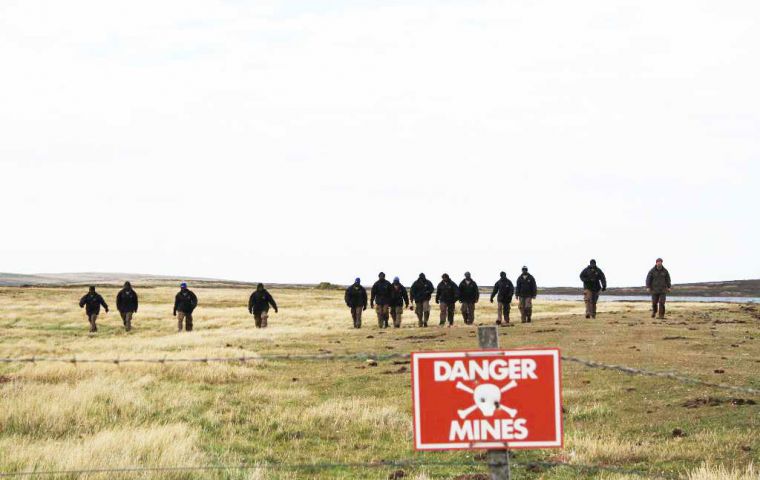MercoPress. South Atlantic News Agency
An option for Falklands? Prototype technology for unearthing minefields in peat soil with fire
 Special teams of deminers working in Falklands' fields clearing them of ordnance
Special teams of deminers working in Falklands' fields clearing them of ordnance Engineers have developed prototype technology that uses controlled burning to partially reveal landmines buried in peat soil. The researchers from Imperial College London have developed technology called O-Revealer that ignites peat, causing a smoldering fire that strips the upper layer of soil to reveal the landmines, making it easier to dispose of them.
The O-Revealer technology consists of an electric power source and a heating coil that is inserted into the top layer of peat. When switched on it slowly heats the peat to 500 degrees Celsius, which ignites it causing a smoldering fire, which is a flameless combustion process, with smoke as the only visible sign that the fire is occurring.
The researchers have so far successfully tested the device in the lab with dummy landmines that were buried in peat soil. They used a fan to simulate wind conditions, which affect the intensity and direction of a smoldering fire, and showed how they could partially unearth the buried landmines.
The engineers who wrote the study, published in the journal Experimental Thermal and Fluid Science, have also shown the areas in the world where O-Revealer may be of most benefit. They did this by cross-referencing world maps of minefields with maps of peat lands. Areas most likely to benefit from O-Revealer technology include the Falkland Islands, Vietnam, Burma, Laos, Uganda, Zimbabwe and former Yugoslavia.
Dr Guillermo Rein, (*) the lead author from the Department of Mechanical Engineering at Imperial, said: “The insidious threat of landmines and their impact on people is well documented around the world. However, the technical and safety challenges in removing these minefields are huge. Even a rich and technologically advanced country such as the UK faces challenges.
”The British Government, for example, had a legal responsibility to remove landmines from the Falkland Islands by 2009, but due to the slow rate and high costs of conventional mine removal techniques they've had to request a ten-year extension to their program.“
The landmine problem worldwide is rising. It is estimated that two to five million landmines are laid every year. Globally, blast injuries caused by landmines currently exceed 26,000 people per year.
However, the clearance of these minefields is ten times slower than the rate at which they are laid, for example, more than 30 years since the 1982 war between Argentina and the United Kingdom only 5,000 landmines out of the original 20,000 anti-personnel and 5,000 anti-tank landmines have been cleared in the Falkland Islands.
”That is why a study like ours is important as we need to find quicker and safer methods for revealing landmines so that they can be removed,” added Dr Rein.
The O-Revealer is based on the controlled use of smoldering combustion. This is the low-temperature, flameless burning of porous fuels. Peat is combustible and prone to smoldering fires. There is a body of scientific literature on the ignition and spread of smoldering fires in peat lands, but this knowledge has not been used before in mine clearance.
In the lab, the Imperial team replicated two of the most common types of landmines – the Italian SB-33 (widely used in the Falklands) and the Serbian PROM-1 (used widely worldwide) – and buried them in peat as part of the tests.
Minimal environmental impact
In terms of the potential environmental impact of burning peat, the team say that they method would be carefully controlled if used in the field. The smoldering fires would be very small. The researchers also say the impact would be minimized by choosing at what time of the year they burn peat.
The next steps will see the team trialing the technology in the field. They will first work at a military test site and then the team would like to trial the technology in the Falkland Islands, working with bomb disposal de-mining teams. They predict that the O-Revealer is around five years from being used in the field. (Imperial College).-
(*) Guillermo Rein et al. Detection of landmines in peat soils by controlled smoldering combustion: Experimental proof of concept of O-Revealer, Experimental Thermal and Fluid Science (2017).




Top Comments
Disclaimer & comment rules-

-

-

Read all commentsWell the idea - to remove mines - is sound.
Aug 24th, 2017 - 09:19 am +3Admittedly the idea should have been to remove mines while not potentially leaving the area a blackened and ash-smeared mess with the potential for recurring fires for decades to come, but you can't have everything
@Fire_Science, you had an extra parenthesis in the link to the journal paper, so link is not working. Corrected link: https://doi.org/10.1016/j.expthermflusci.2017.07.016
Aug 26th, 2017 - 02:36 pm +2Photo looks more like some military folks - deminers here are from Zimbabwe. Also if not ready for 5 yrs to try will be irrelevant to Falklands as plan is all areas will be clear before then.Also the last thing one wants to do is set fire to peat! We don't really want to burn half the Islands away to ash and rock!! Once started a fire in peapy ground can go deeo and smoulder way down for several years, periodically resurfacing in new areas and can take a lot of environmentally damaging deep bulldozing to contain it and stop even more destruction.
Aug 23rd, 2017 - 11:12 am +1Me thinks they need to rethink a bit!
Commenting for this story is now closed.
If you have a Facebook account, become a fan and comment on our Facebook Page!